Dissertation: Social Media's Impact on Consumer Behavior at EE Mobile
VerifiedAdded on 2021/04/16
|34
|7769
|64
Dissertation
AI Summary
This dissertation investigates the impact of social media on consumer buying behavior, focusing on the context of EE Mobile in the UK. The research begins with an introduction outlining the background, aim, objectives, and research questions, followed by an explanation of the organizational structure. The methodology section details the interpretivism research philosophy, inductive approach, survey strategy, and both qualitative and quantitative research designs, along with data collection methods, sampling procedures, ethical considerations, and limitations. A comprehensive literature review examines the conceptual understanding of social media and consumer buying behavior. The data analysis chapter presents findings through charts and tables, analyzing demographic factors and responses related to research objectives. The findings and discussion chapter interprets the analyzed data in relation to the literature review. The conclusion summarizes the research, connecting objectives and findings to provide a valid conclusion. The dissertation includes references and an appendix with supporting materials.
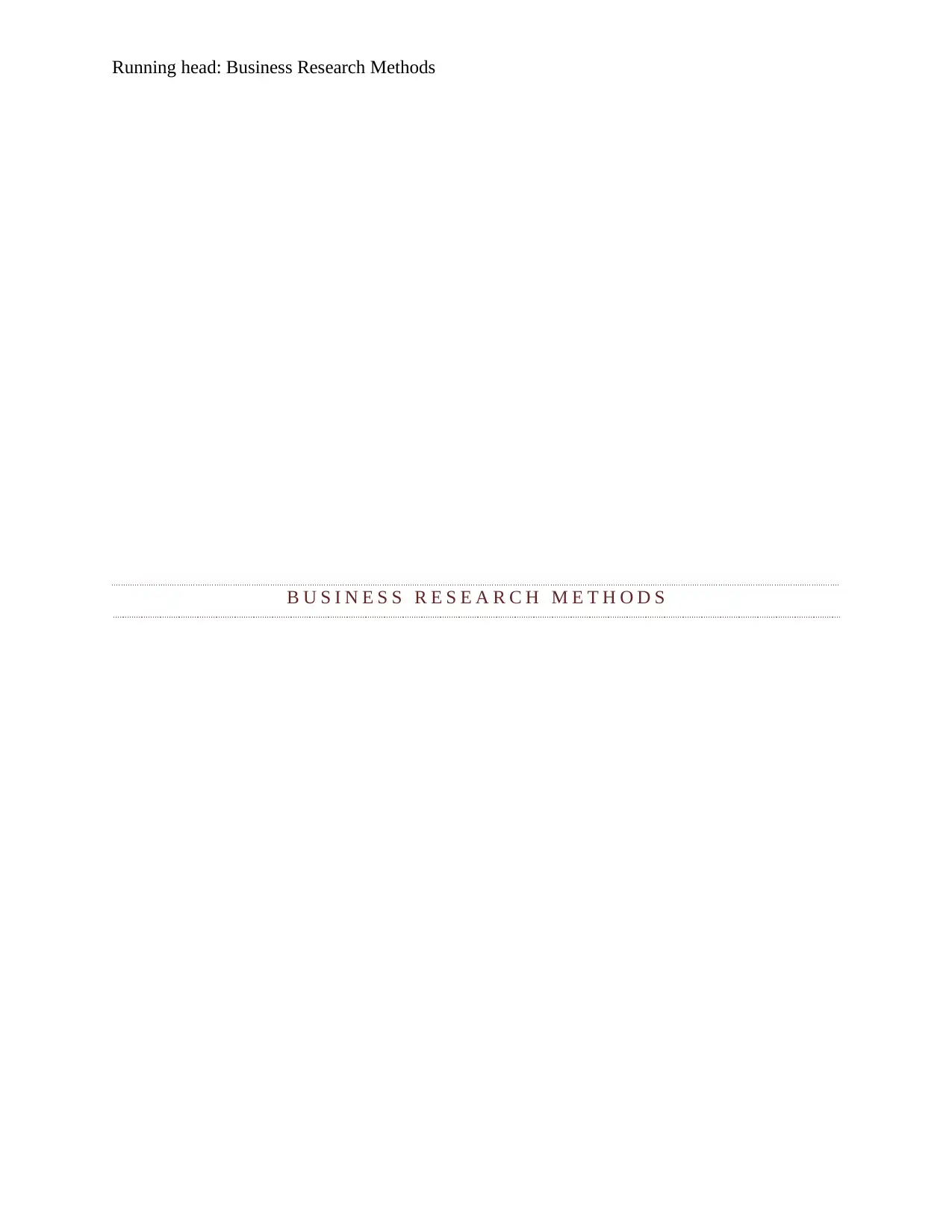
Running head: Business Research Methods
B U S I N E S S R E S E A R C H M E T H O D S
B U S I N E S S R E S E A R C H M E T H O D S
Paraphrase This Document
Need a fresh take? Get an instant paraphrase of this document with our AI Paraphraser
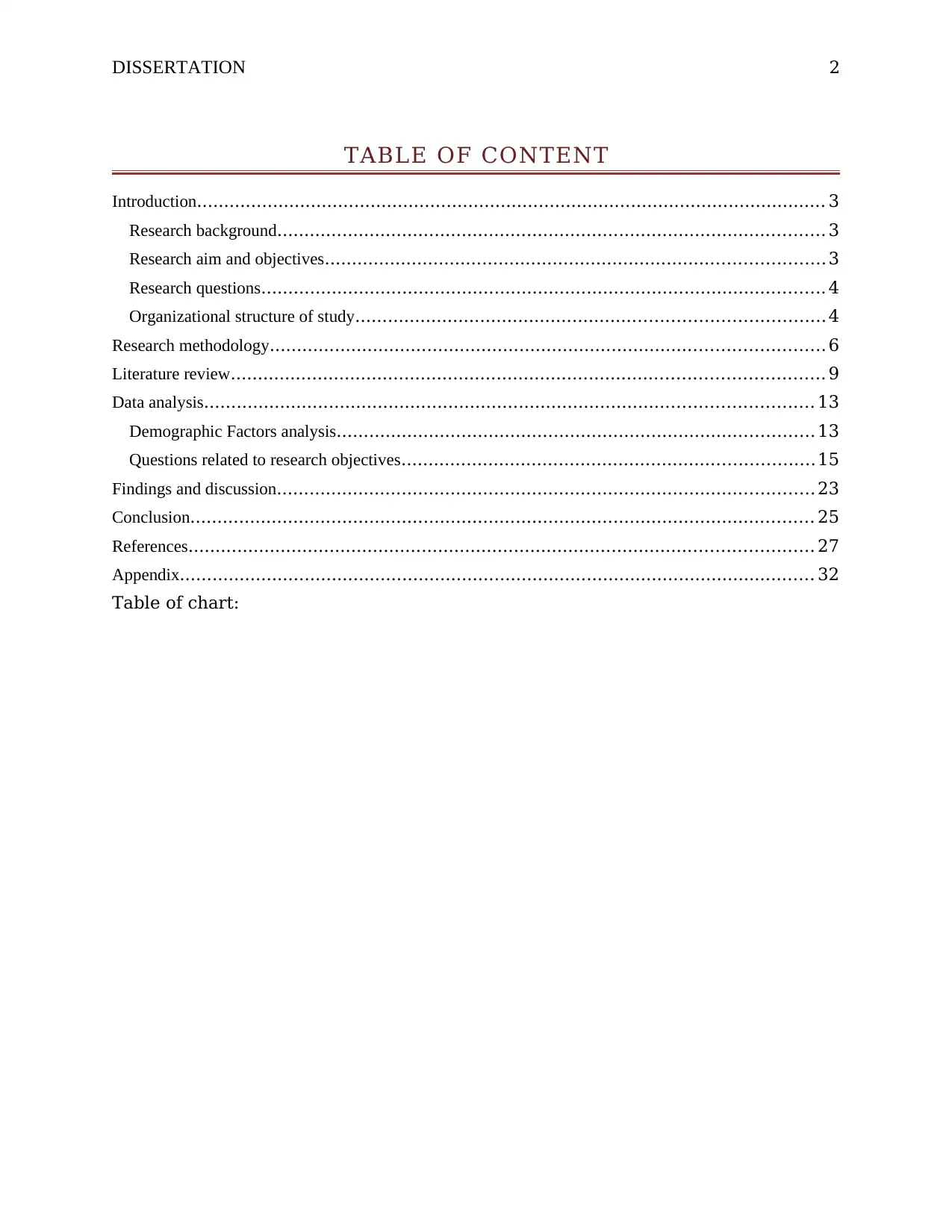
DISSERTATION 2
TABLE OF CONTENT
Introduction.................................................................................................................... 3
Research background..................................................................................................... 3
Research aim and objectives............................................................................................ 3
Research questions........................................................................................................ 4
Organizational structure of study...................................................................................... 4
Research methodology...................................................................................................... 6
Literature review............................................................................................................. 9
Data analysis................................................................................................................ 13
Demographic Factors analysis........................................................................................ 13
Questions related to research objectives............................................................................15
Findings and discussion................................................................................................... 23
Conclusion................................................................................................................... 25
References................................................................................................................... 27
Appendix..................................................................................................................... 32
Table of chart:
TABLE OF CONTENT
Introduction.................................................................................................................... 3
Research background..................................................................................................... 3
Research aim and objectives............................................................................................ 3
Research questions........................................................................................................ 4
Organizational structure of study...................................................................................... 4
Research methodology...................................................................................................... 6
Literature review............................................................................................................. 9
Data analysis................................................................................................................ 13
Demographic Factors analysis........................................................................................ 13
Questions related to research objectives............................................................................15
Findings and discussion................................................................................................... 23
Conclusion................................................................................................................... 25
References................................................................................................................... 27
Appendix..................................................................................................................... 32
Table of chart:
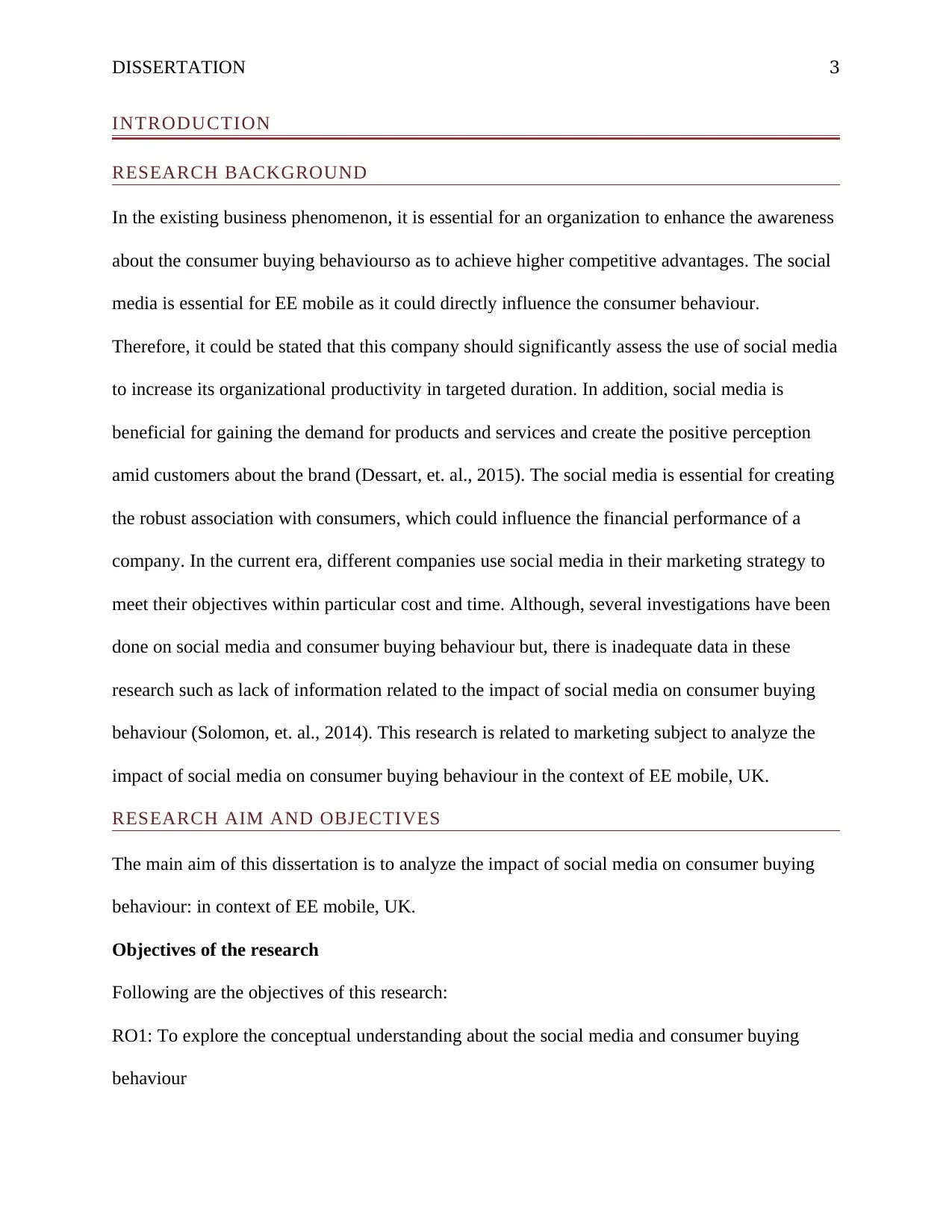
DISSERTATION 3
INTRODUCTION
RESEARCH BACKGROUND
In the existing business phenomenon, it is essential for an organization to enhance the awareness
about the consumer buying behaviourso as to achieve higher competitive advantages. The social
media is essential for EE mobile as it could directly influence the consumer behaviour.
Therefore, it could be stated that this company should significantly assess the use of social media
to increase its organizational productivity in targeted duration. In addition, social media is
beneficial for gaining the demand for products and services and create the positive perception
amid customers about the brand (Dessart, et. al., 2015). The social media is essential for creating
the robust association with consumers, which could influence the financial performance of a
company. In the current era, different companies use social media in their marketing strategy to
meet their objectives within particular cost and time. Although, several investigations have been
done on social media and consumer buying behaviour but, there is inadequate data in these
research such as lack of information related to the impact of social media on consumer buying
behaviour (Solomon, et. al., 2014). This research is related to marketing subject to analyze the
impact of social media on consumer buying behaviour in the context of EE mobile, UK.
RESEARCH AIM AND OBJECTIVES
The main aim of this dissertation is to analyze the impact of social media on consumer buying
behaviour: in context of EE mobile, UK.
Objectives of the research
Following are the objectives of this research:
RO1: To explore the conceptual understanding about the social media and consumer buying
behaviour
INTRODUCTION
RESEARCH BACKGROUND
In the existing business phenomenon, it is essential for an organization to enhance the awareness
about the consumer buying behaviourso as to achieve higher competitive advantages. The social
media is essential for EE mobile as it could directly influence the consumer behaviour.
Therefore, it could be stated that this company should significantly assess the use of social media
to increase its organizational productivity in targeted duration. In addition, social media is
beneficial for gaining the demand for products and services and create the positive perception
amid customers about the brand (Dessart, et. al., 2015). The social media is essential for creating
the robust association with consumers, which could influence the financial performance of a
company. In the current era, different companies use social media in their marketing strategy to
meet their objectives within particular cost and time. Although, several investigations have been
done on social media and consumer buying behaviour but, there is inadequate data in these
research such as lack of information related to the impact of social media on consumer buying
behaviour (Solomon, et. al., 2014). This research is related to marketing subject to analyze the
impact of social media on consumer buying behaviour in the context of EE mobile, UK.
RESEARCH AIM AND OBJECTIVES
The main aim of this dissertation is to analyze the impact of social media on consumer buying
behaviour: in context of EE mobile, UK.
Objectives of the research
Following are the objectives of this research:
RO1: To explore the conceptual understanding about the social media and consumer buying
behaviour
⊘ This is a preview!⊘
Do you want full access?
Subscribe today to unlock all pages.

Trusted by 1+ million students worldwide
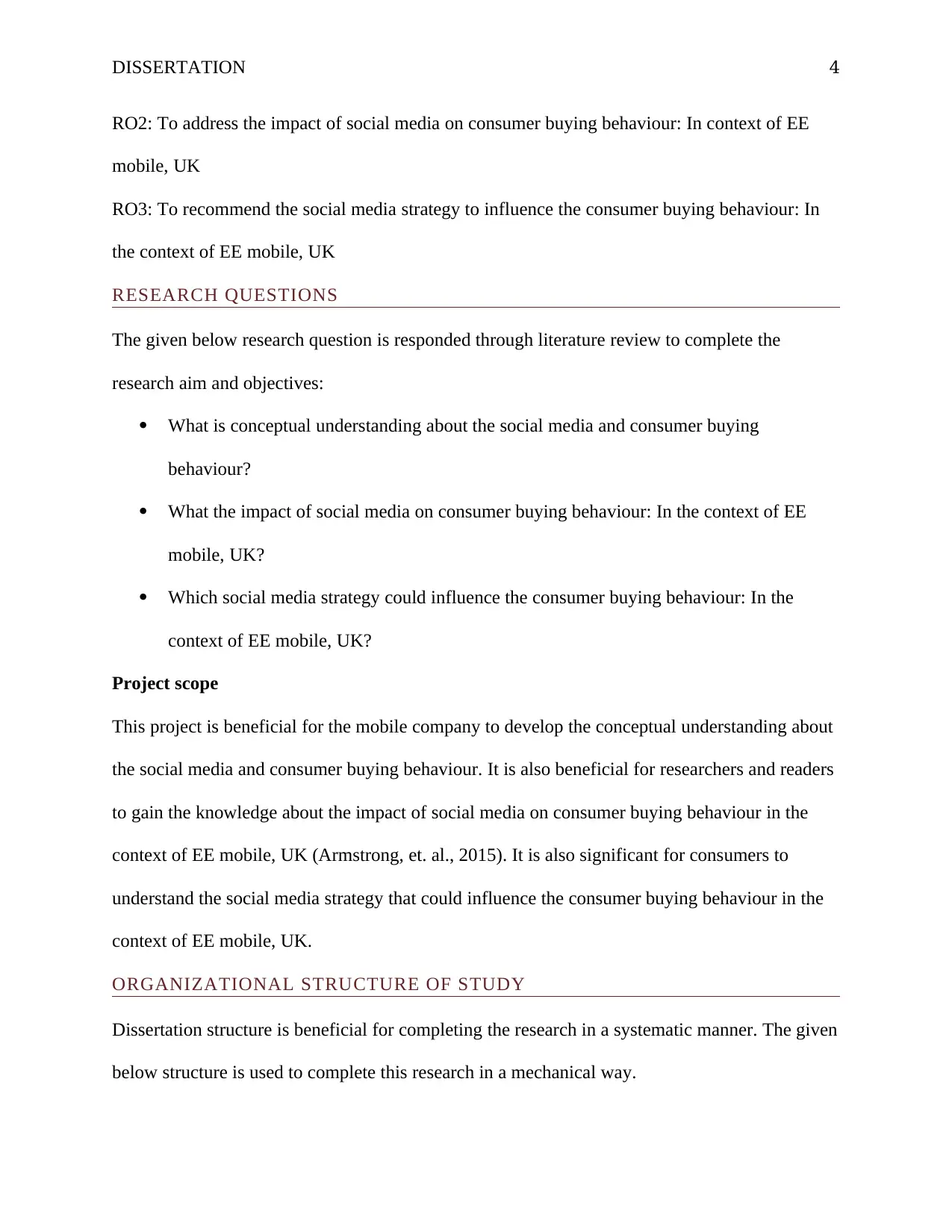
DISSERTATION 4
RO2: To address the impact of social media on consumer buying behaviour: In context of EE
mobile, UK
RO3: To recommend the social media strategy to influence the consumer buying behaviour: In
the context of EE mobile, UK
RESEARCH QUESTIONS
The given below research question is responded through literature review to complete the
research aim and objectives:
What is conceptual understanding about the social media and consumer buying
behaviour?
What the impact of social media on consumer buying behaviour: In the context of EE
mobile, UK?
Which social media strategy could influence the consumer buying behaviour: In the
context of EE mobile, UK?
Project scope
This project is beneficial for the mobile company to develop the conceptual understanding about
the social media and consumer buying behaviour. It is also beneficial for researchers and readers
to gain the knowledge about the impact of social media on consumer buying behaviour in the
context of EE mobile, UK (Armstrong, et. al., 2015). It is also significant for consumers to
understand the social media strategy that could influence the consumer buying behaviour in the
context of EE mobile, UK.
ORGANIZATIONAL STRUCTURE OF STUDY
Dissertation structure is beneficial for completing the research in a systematic manner. The given
below structure is used to complete this research in a mechanical way.
RO2: To address the impact of social media on consumer buying behaviour: In context of EE
mobile, UK
RO3: To recommend the social media strategy to influence the consumer buying behaviour: In
the context of EE mobile, UK
RESEARCH QUESTIONS
The given below research question is responded through literature review to complete the
research aim and objectives:
What is conceptual understanding about the social media and consumer buying
behaviour?
What the impact of social media on consumer buying behaviour: In the context of EE
mobile, UK?
Which social media strategy could influence the consumer buying behaviour: In the
context of EE mobile, UK?
Project scope
This project is beneficial for the mobile company to develop the conceptual understanding about
the social media and consumer buying behaviour. It is also beneficial for researchers and readers
to gain the knowledge about the impact of social media on consumer buying behaviour in the
context of EE mobile, UK (Armstrong, et. al., 2015). It is also significant for consumers to
understand the social media strategy that could influence the consumer buying behaviour in the
context of EE mobile, UK.
ORGANIZATIONAL STRUCTURE OF STUDY
Dissertation structure is beneficial for completing the research in a systematic manner. The given
below structure is used to complete this research in a mechanical way.
Paraphrase This Document
Need a fresh take? Get an instant paraphrase of this document with our AI Paraphraser
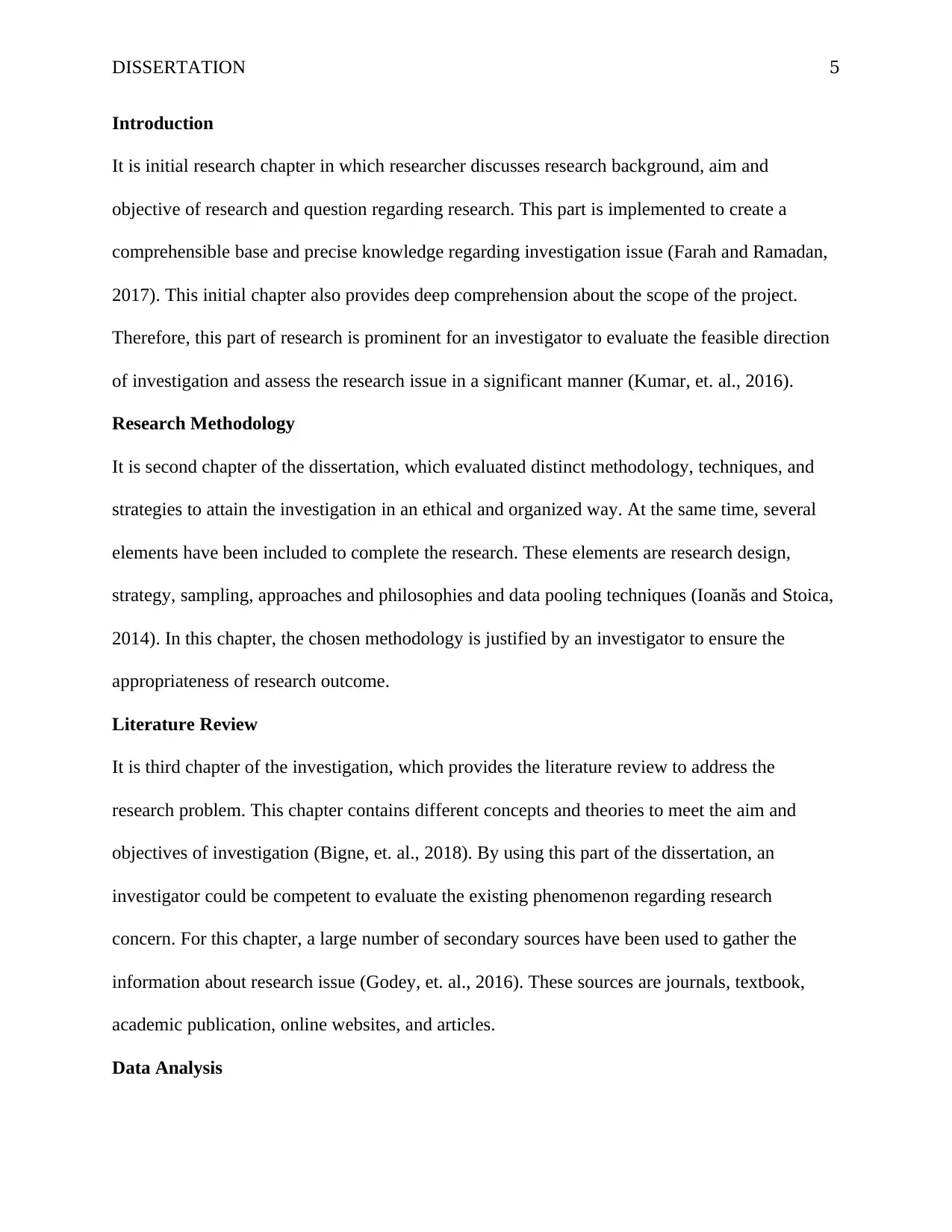
DISSERTATION 5
Introduction
It is initial research chapter in which researcher discusses research background, aim and
objective of research and question regarding research. This part is implemented to create a
comprehensible base and precise knowledge regarding investigation issue (Farah and Ramadan,
2017). This initial chapter also provides deep comprehension about the scope of the project.
Therefore, this part of research is prominent for an investigator to evaluate the feasible direction
of investigation and assess the research issue in a significant manner (Kumar, et. al., 2016).
Research Methodology
It is second chapter of the dissertation, which evaluated distinct methodology, techniques, and
strategies to attain the investigation in an ethical and organized way. At the same time, several
elements have been included to complete the research. These elements are research design,
strategy, sampling, approaches and philosophies and data pooling techniques (Ioanăs and Stoica,
2014). In this chapter, the chosen methodology is justified by an investigator to ensure the
appropriateness of research outcome.
Literature Review
It is third chapter of the investigation, which provides the literature review to address the
research problem. This chapter contains different concepts and theories to meet the aim and
objectives of investigation (Bigne, et. al., 2018). By using this part of the dissertation, an
investigator could be competent to evaluate the existing phenomenon regarding research
concern. For this chapter, a large number of secondary sources have been used to gather the
information about research issue (Godey, et. al., 2016). These sources are journals, textbook,
academic publication, online websites, and articles.
Data Analysis
Introduction
It is initial research chapter in which researcher discusses research background, aim and
objective of research and question regarding research. This part is implemented to create a
comprehensible base and precise knowledge regarding investigation issue (Farah and Ramadan,
2017). This initial chapter also provides deep comprehension about the scope of the project.
Therefore, this part of research is prominent for an investigator to evaluate the feasible direction
of investigation and assess the research issue in a significant manner (Kumar, et. al., 2016).
Research Methodology
It is second chapter of the dissertation, which evaluated distinct methodology, techniques, and
strategies to attain the investigation in an ethical and organized way. At the same time, several
elements have been included to complete the research. These elements are research design,
strategy, sampling, approaches and philosophies and data pooling techniques (Ioanăs and Stoica,
2014). In this chapter, the chosen methodology is justified by an investigator to ensure the
appropriateness of research outcome.
Literature Review
It is third chapter of the investigation, which provides the literature review to address the
research problem. This chapter contains different concepts and theories to meet the aim and
objectives of investigation (Bigne, et. al., 2018). By using this part of the dissertation, an
investigator could be competent to evaluate the existing phenomenon regarding research
concern. For this chapter, a large number of secondary sources have been used to gather the
information about research issue (Godey, et. al., 2016). These sources are journals, textbook,
academic publication, online websites, and articles.
Data Analysis
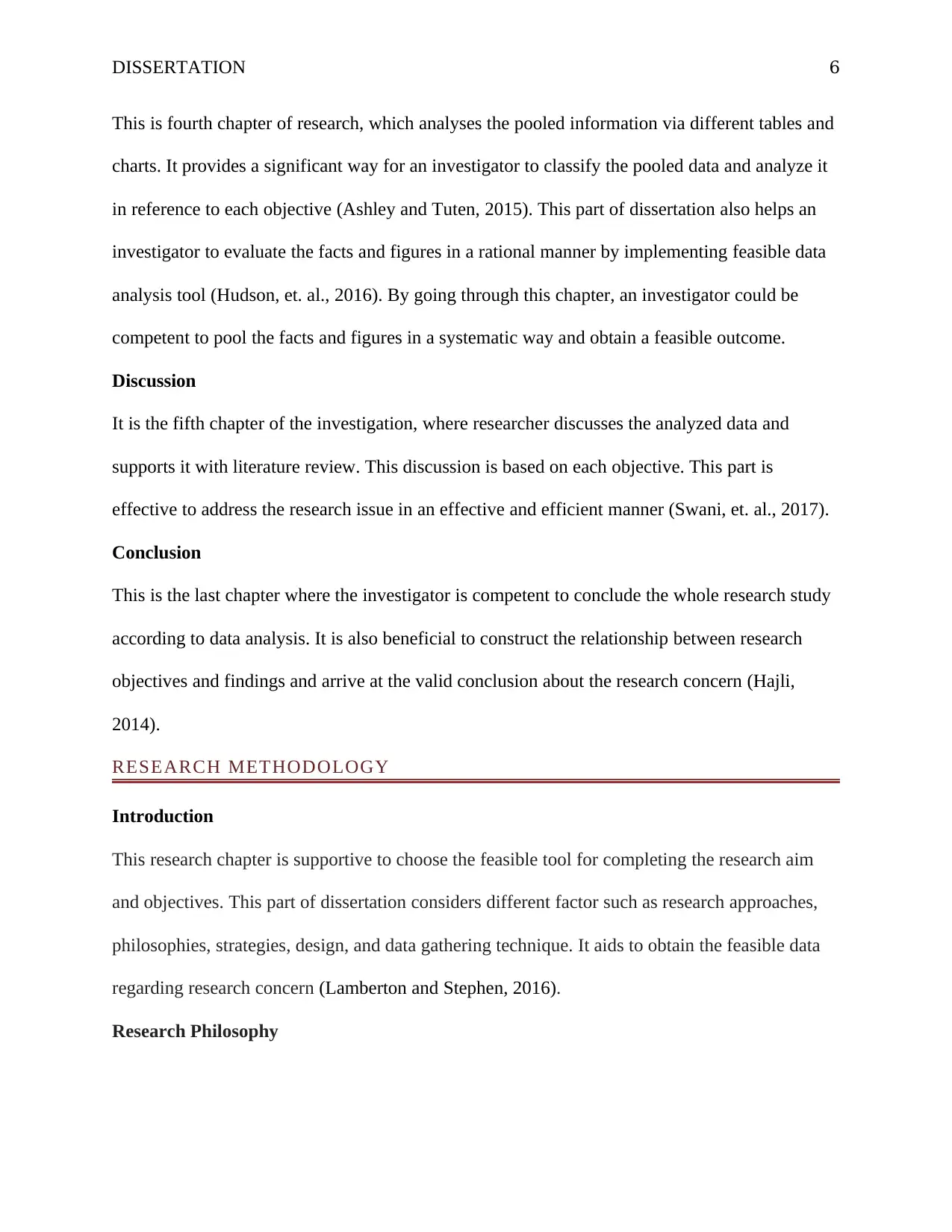
DISSERTATION 6
This is fourth chapter of research, which analyses the pooled information via different tables and
charts. It provides a significant way for an investigator to classify the pooled data and analyze it
in reference to each objective (Ashley and Tuten, 2015). This part of dissertation also helps an
investigator to evaluate the facts and figures in a rational manner by implementing feasible data
analysis tool (Hudson, et. al., 2016). By going through this chapter, an investigator could be
competent to pool the facts and figures in a systematic way and obtain a feasible outcome.
Discussion
It is the fifth chapter of the investigation, where researcher discusses the analyzed data and
supports it with literature review. This discussion is based on each objective. This part is
effective to address the research issue in an effective and efficient manner (Swani, et. al., 2017).
Conclusion
This is the last chapter where the investigator is competent to conclude the whole research study
according to data analysis. It is also beneficial to construct the relationship between research
objectives and findings and arrive at the valid conclusion about the research concern (Hajli,
2014).
RESEARCH METHODOLOGY
Introduction
This research chapter is supportive to choose the feasible tool for completing the research aim
and objectives. This part of dissertation considers different factor such as research approaches,
philosophies, strategies, design, and data gathering technique. It aids to obtain the feasible data
regarding research concern (Lamberton and Stephen, 2016).
Research Philosophy
This is fourth chapter of research, which analyses the pooled information via different tables and
charts. It provides a significant way for an investigator to classify the pooled data and analyze it
in reference to each objective (Ashley and Tuten, 2015). This part of dissertation also helps an
investigator to evaluate the facts and figures in a rational manner by implementing feasible data
analysis tool (Hudson, et. al., 2016). By going through this chapter, an investigator could be
competent to pool the facts and figures in a systematic way and obtain a feasible outcome.
Discussion
It is the fifth chapter of the investigation, where researcher discusses the analyzed data and
supports it with literature review. This discussion is based on each objective. This part is
effective to address the research issue in an effective and efficient manner (Swani, et. al., 2017).
Conclusion
This is the last chapter where the investigator is competent to conclude the whole research study
according to data analysis. It is also beneficial to construct the relationship between research
objectives and findings and arrive at the valid conclusion about the research concern (Hajli,
2014).
RESEARCH METHODOLOGY
Introduction
This research chapter is supportive to choose the feasible tool for completing the research aim
and objectives. This part of dissertation considers different factor such as research approaches,
philosophies, strategies, design, and data gathering technique. It aids to obtain the feasible data
regarding research concern (Lamberton and Stephen, 2016).
Research Philosophy
⊘ This is a preview!⊘
Do you want full access?
Subscribe today to unlock all pages.

Trusted by 1+ million students worldwide
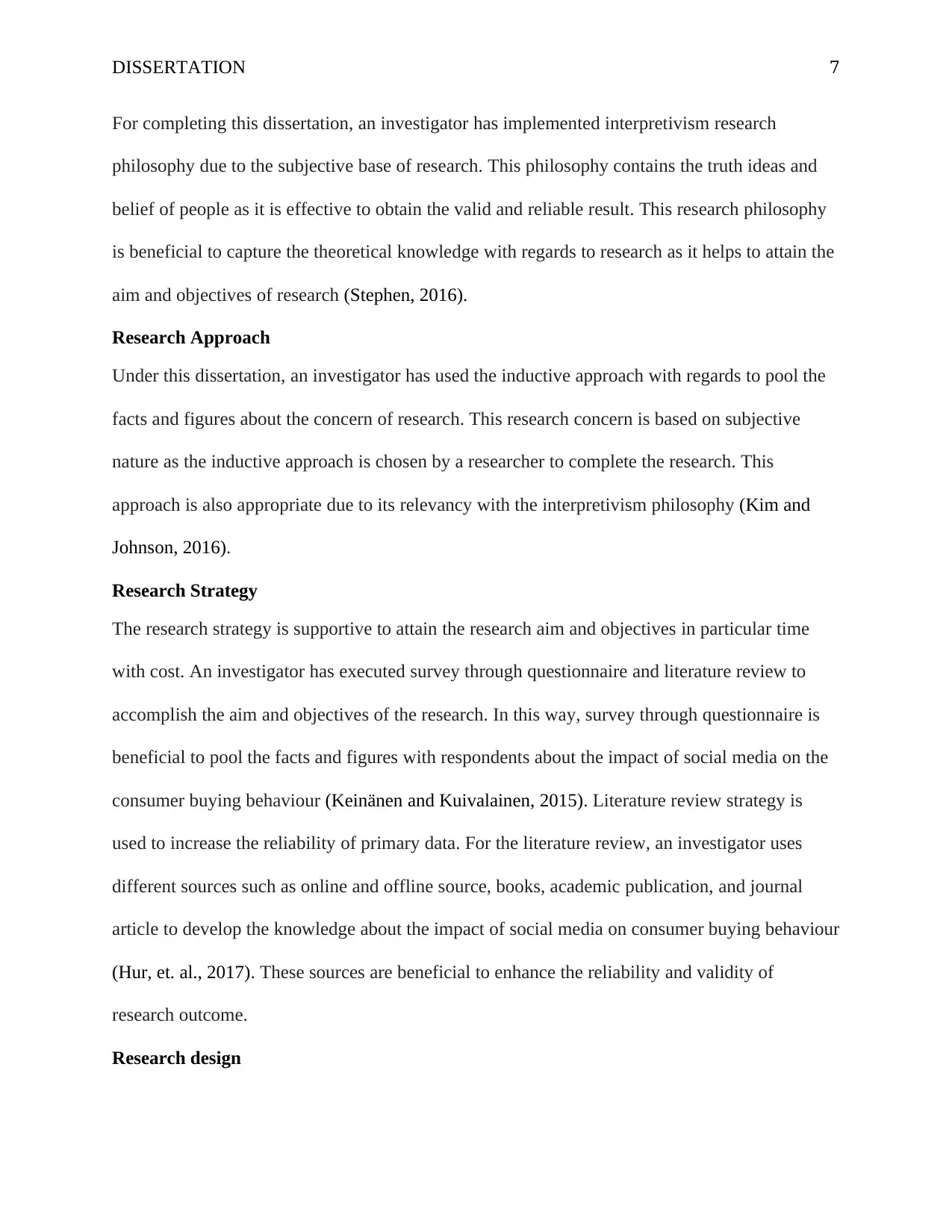
DISSERTATION 7
For completing this dissertation, an investigator has implemented interpretivism research
philosophy due to the subjective base of research. This philosophy contains the truth ideas and
belief of people as it is effective to obtain the valid and reliable result. This research philosophy
is beneficial to capture the theoretical knowledge with regards to research as it helps to attain the
aim and objectives of research (Stephen, 2016).
Research Approach
Under this dissertation, an investigator has used the inductive approach with regards to pool the
facts and figures about the concern of research. This research concern is based on subjective
nature as the inductive approach is chosen by a researcher to complete the research. This
approach is also appropriate due to its relevancy with the interpretivism philosophy (Kim and
Johnson, 2016).
Research Strategy
The research strategy is supportive to attain the research aim and objectives in particular time
with cost. An investigator has executed survey through questionnaire and literature review to
accomplish the aim and objectives of the research. In this way, survey through questionnaire is
beneficial to pool the facts and figures with respondents about the impact of social media on the
consumer buying behaviour (Keinänen and Kuivalainen, 2015). Literature review strategy is
used to increase the reliability of primary data. For the literature review, an investigator uses
different sources such as online and offline source, books, academic publication, and journal
article to develop the knowledge about the impact of social media on consumer buying behaviour
(Hur, et. al., 2017). These sources are beneficial to enhance the reliability and validity of
research outcome.
Research design
For completing this dissertation, an investigator has implemented interpretivism research
philosophy due to the subjective base of research. This philosophy contains the truth ideas and
belief of people as it is effective to obtain the valid and reliable result. This research philosophy
is beneficial to capture the theoretical knowledge with regards to research as it helps to attain the
aim and objectives of research (Stephen, 2016).
Research Approach
Under this dissertation, an investigator has used the inductive approach with regards to pool the
facts and figures about the concern of research. This research concern is based on subjective
nature as the inductive approach is chosen by a researcher to complete the research. This
approach is also appropriate due to its relevancy with the interpretivism philosophy (Kim and
Johnson, 2016).
Research Strategy
The research strategy is supportive to attain the research aim and objectives in particular time
with cost. An investigator has executed survey through questionnaire and literature review to
accomplish the aim and objectives of the research. In this way, survey through questionnaire is
beneficial to pool the facts and figures with respondents about the impact of social media on the
consumer buying behaviour (Keinänen and Kuivalainen, 2015). Literature review strategy is
used to increase the reliability of primary data. For the literature review, an investigator uses
different sources such as online and offline source, books, academic publication, and journal
article to develop the knowledge about the impact of social media on consumer buying behaviour
(Hur, et. al., 2017). These sources are beneficial to enhance the reliability and validity of
research outcome.
Research design
Paraphrase This Document
Need a fresh take? Get an instant paraphrase of this document with our AI Paraphraser
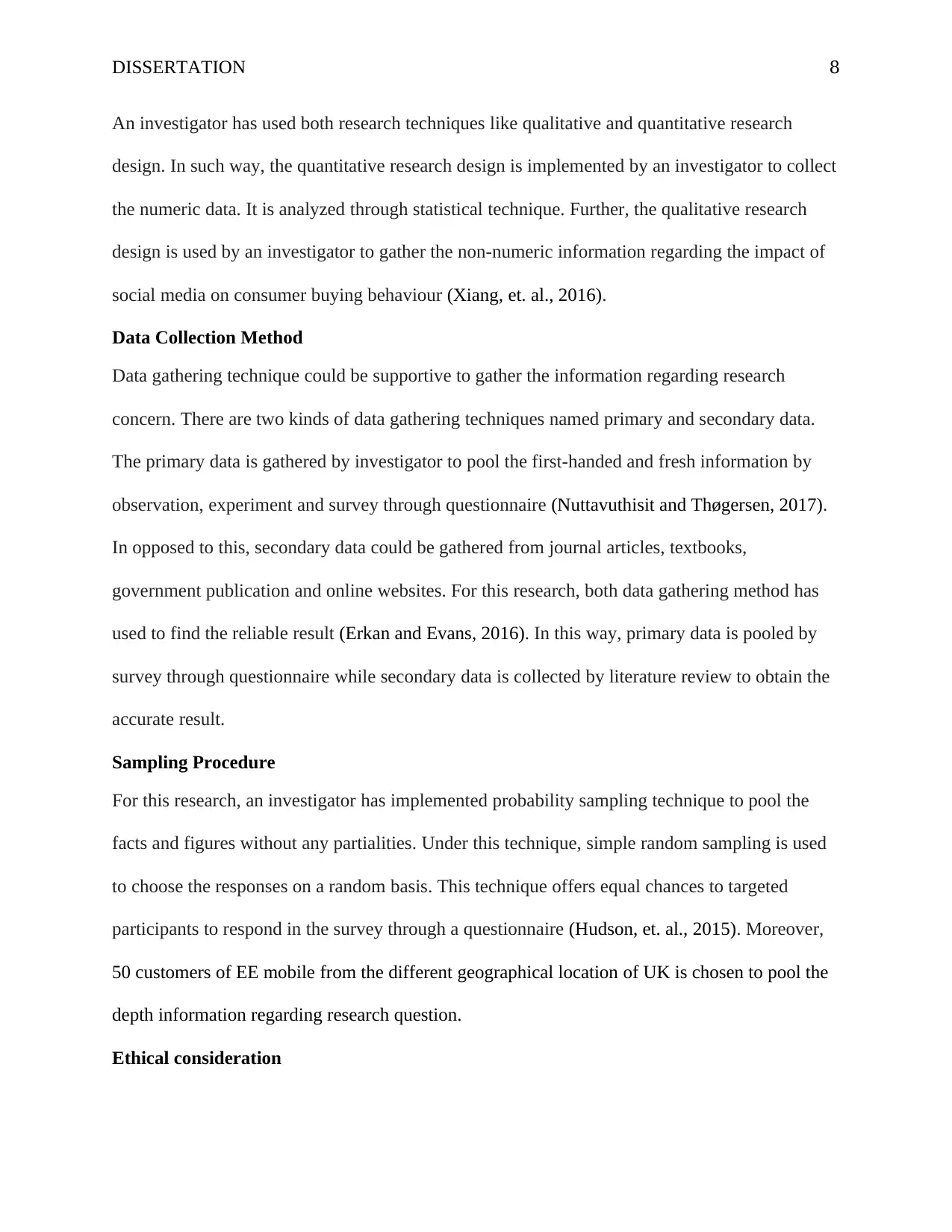
DISSERTATION 8
An investigator has used both research techniques like qualitative and quantitative research
design. In such way, the quantitative research design is implemented by an investigator to collect
the numeric data. It is analyzed through statistical technique. Further, the qualitative research
design is used by an investigator to gather the non-numeric information regarding the impact of
social media on consumer buying behaviour (Xiang, et. al., 2016).
Data Collection Method
Data gathering technique could be supportive to gather the information regarding research
concern. There are two kinds of data gathering techniques named primary and secondary data.
The primary data is gathered by investigator to pool the first-handed and fresh information by
observation, experiment and survey through questionnaire (Nuttavuthisit and Thøgersen, 2017).
In opposed to this, secondary data could be gathered from journal articles, textbooks,
government publication and online websites. For this research, both data gathering method has
used to find the reliable result (Erkan and Evans, 2016). In this way, primary data is pooled by
survey through questionnaire while secondary data is collected by literature review to obtain the
accurate result.
Sampling Procedure
For this research, an investigator has implemented probability sampling technique to pool the
facts and figures without any partialities. Under this technique, simple random sampling is used
to choose the responses on a random basis. This technique offers equal chances to targeted
participants to respond in the survey through a questionnaire (Hudson, et. al., 2015). Moreover,
50 customers of EE mobile from the different geographical location of UK is chosen to pool the
depth information regarding research question.
Ethical consideration
An investigator has used both research techniques like qualitative and quantitative research
design. In such way, the quantitative research design is implemented by an investigator to collect
the numeric data. It is analyzed through statistical technique. Further, the qualitative research
design is used by an investigator to gather the non-numeric information regarding the impact of
social media on consumer buying behaviour (Xiang, et. al., 2016).
Data Collection Method
Data gathering technique could be supportive to gather the information regarding research
concern. There are two kinds of data gathering techniques named primary and secondary data.
The primary data is gathered by investigator to pool the first-handed and fresh information by
observation, experiment and survey through questionnaire (Nuttavuthisit and Thøgersen, 2017).
In opposed to this, secondary data could be gathered from journal articles, textbooks,
government publication and online websites. For this research, both data gathering method has
used to find the reliable result (Erkan and Evans, 2016). In this way, primary data is pooled by
survey through questionnaire while secondary data is collected by literature review to obtain the
accurate result.
Sampling Procedure
For this research, an investigator has implemented probability sampling technique to pool the
facts and figures without any partialities. Under this technique, simple random sampling is used
to choose the responses on a random basis. This technique offers equal chances to targeted
participants to respond in the survey through a questionnaire (Hudson, et. al., 2015). Moreover,
50 customers of EE mobile from the different geographical location of UK is chosen to pool the
depth information regarding research question.
Ethical consideration
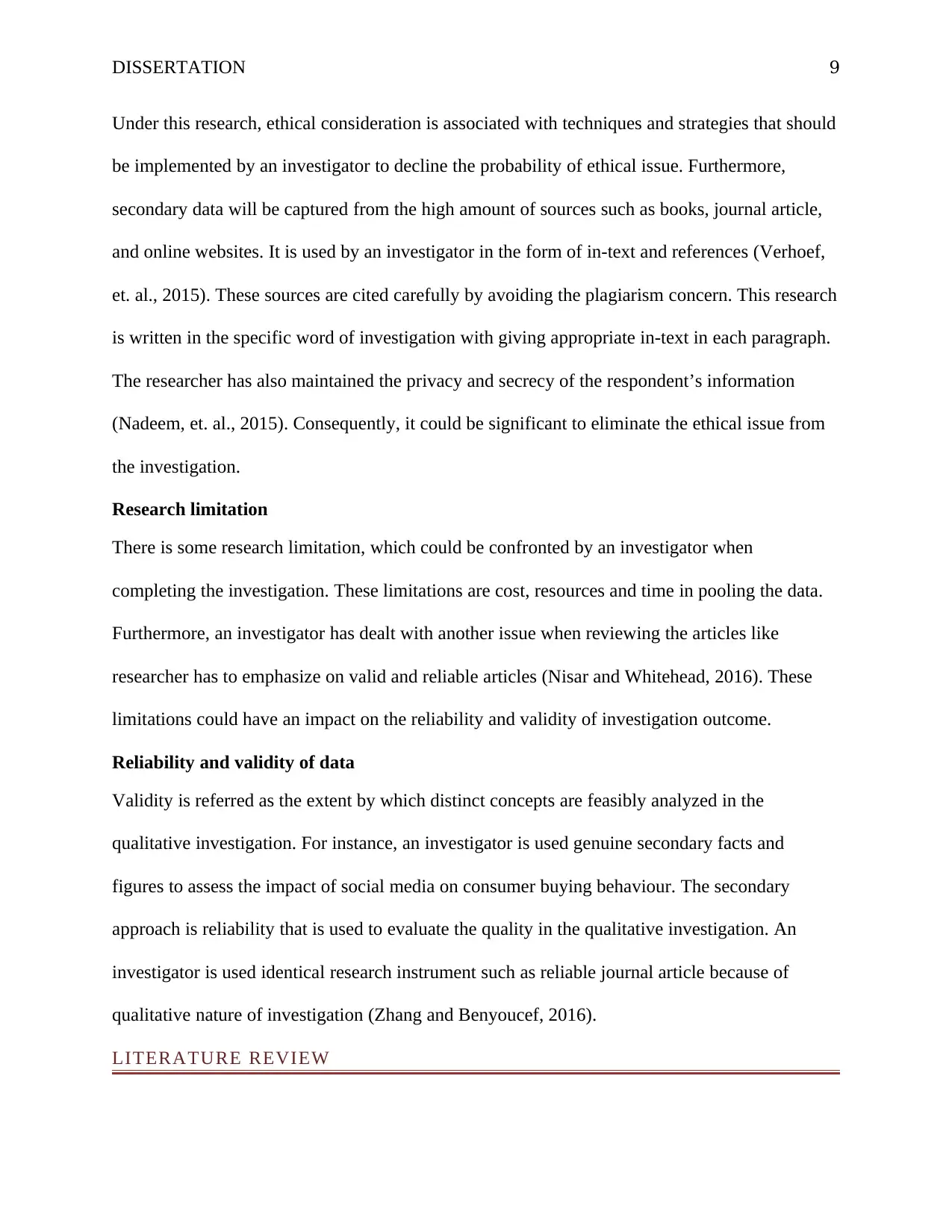
DISSERTATION 9
Under this research, ethical consideration is associated with techniques and strategies that should
be implemented by an investigator to decline the probability of ethical issue. Furthermore,
secondary data will be captured from the high amount of sources such as books, journal article,
and online websites. It is used by an investigator in the form of in-text and references (Verhoef,
et. al., 2015). These sources are cited carefully by avoiding the plagiarism concern. This research
is written in the specific word of investigation with giving appropriate in-text in each paragraph.
The researcher has also maintained the privacy and secrecy of the respondent’s information
(Nadeem, et. al., 2015). Consequently, it could be significant to eliminate the ethical issue from
the investigation.
Research limitation
There is some research limitation, which could be confronted by an investigator when
completing the investigation. These limitations are cost, resources and time in pooling the data.
Furthermore, an investigator has dealt with another issue when reviewing the articles like
researcher has to emphasize on valid and reliable articles (Nisar and Whitehead, 2016). These
limitations could have an impact on the reliability and validity of investigation outcome.
Reliability and validity of data
Validity is referred as the extent by which distinct concepts are feasibly analyzed in the
qualitative investigation. For instance, an investigator is used genuine secondary facts and
figures to assess the impact of social media on consumer buying behaviour. The secondary
approach is reliability that is used to evaluate the quality in the qualitative investigation. An
investigator is used identical research instrument such as reliable journal article because of
qualitative nature of investigation (Zhang and Benyoucef, 2016).
LITERATURE REVIEW
Under this research, ethical consideration is associated with techniques and strategies that should
be implemented by an investigator to decline the probability of ethical issue. Furthermore,
secondary data will be captured from the high amount of sources such as books, journal article,
and online websites. It is used by an investigator in the form of in-text and references (Verhoef,
et. al., 2015). These sources are cited carefully by avoiding the plagiarism concern. This research
is written in the specific word of investigation with giving appropriate in-text in each paragraph.
The researcher has also maintained the privacy and secrecy of the respondent’s information
(Nadeem, et. al., 2015). Consequently, it could be significant to eliminate the ethical issue from
the investigation.
Research limitation
There is some research limitation, which could be confronted by an investigator when
completing the investigation. These limitations are cost, resources and time in pooling the data.
Furthermore, an investigator has dealt with another issue when reviewing the articles like
researcher has to emphasize on valid and reliable articles (Nisar and Whitehead, 2016). These
limitations could have an impact on the reliability and validity of investigation outcome.
Reliability and validity of data
Validity is referred as the extent by which distinct concepts are feasibly analyzed in the
qualitative investigation. For instance, an investigator is used genuine secondary facts and
figures to assess the impact of social media on consumer buying behaviour. The secondary
approach is reliability that is used to evaluate the quality in the qualitative investigation. An
investigator is used identical research instrument such as reliable journal article because of
qualitative nature of investigation (Zhang and Benyoucef, 2016).
LITERATURE REVIEW
⊘ This is a preview!⊘
Do you want full access?
Subscribe today to unlock all pages.

Trusted by 1+ million students worldwide
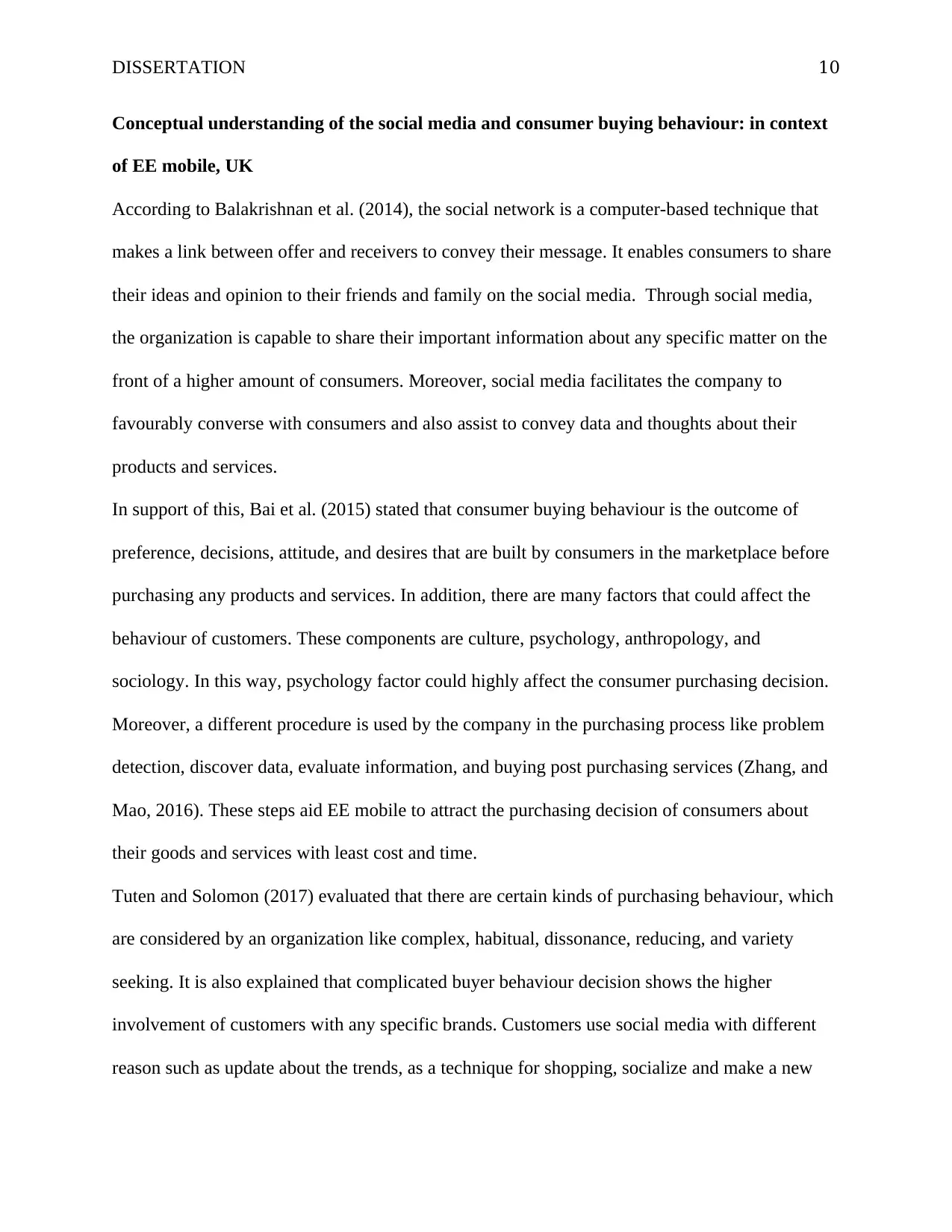
DISSERTATION 10
Conceptual understanding of the social media and consumer buying behaviour: in context
of EE mobile, UK
According to Balakrishnan et al. (2014), the social network is a computer-based technique that
makes a link between offer and receivers to convey their message. It enables consumers to share
their ideas and opinion to their friends and family on the social media. Through social media,
the organization is capable to share their important information about any specific matter on the
front of a higher amount of consumers. Moreover, social media facilitates the company to
favourably converse with consumers and also assist to convey data and thoughts about their
products and services.
In support of this, Bai et al. (2015) stated that consumer buying behaviour is the outcome of
preference, decisions, attitude, and desires that are built by consumers in the marketplace before
purchasing any products and services. In addition, there are many factors that could affect the
behaviour of customers. These components are culture, psychology, anthropology, and
sociology. In this way, psychology factor could highly affect the consumer purchasing decision.
Moreover, a different procedure is used by the company in the purchasing process like problem
detection, discover data, evaluate information, and buying post purchasing services (Zhang, and
Mao, 2016). These steps aid EE mobile to attract the purchasing decision of consumers about
their goods and services with least cost and time.
Tuten and Solomon (2017) evaluated that there are certain kinds of purchasing behaviour, which
are considered by an organization like complex, habitual, dissonance, reducing, and variety
seeking. It is also explained that complicated buyer behaviour decision shows the higher
involvement of customers with any specific brands. Customers use social media with different
reason such as update about the trends, as a technique for shopping, socialize and make a new
Conceptual understanding of the social media and consumer buying behaviour: in context
of EE mobile, UK
According to Balakrishnan et al. (2014), the social network is a computer-based technique that
makes a link between offer and receivers to convey their message. It enables consumers to share
their ideas and opinion to their friends and family on the social media. Through social media,
the organization is capable to share their important information about any specific matter on the
front of a higher amount of consumers. Moreover, social media facilitates the company to
favourably converse with consumers and also assist to convey data and thoughts about their
products and services.
In support of this, Bai et al. (2015) stated that consumer buying behaviour is the outcome of
preference, decisions, attitude, and desires that are built by consumers in the marketplace before
purchasing any products and services. In addition, there are many factors that could affect the
behaviour of customers. These components are culture, psychology, anthropology, and
sociology. In this way, psychology factor could highly affect the consumer purchasing decision.
Moreover, a different procedure is used by the company in the purchasing process like problem
detection, discover data, evaluate information, and buying post purchasing services (Zhang, and
Mao, 2016). These steps aid EE mobile to attract the purchasing decision of consumers about
their goods and services with least cost and time.
Tuten and Solomon (2017) evaluated that there are certain kinds of purchasing behaviour, which
are considered by an organization like complex, habitual, dissonance, reducing, and variety
seeking. It is also explained that complicated buyer behaviour decision shows the higher
involvement of customers with any specific brands. Customers use social media with different
reason such as update about the trends, as a technique for shopping, socialize and make a new
Paraphrase This Document
Need a fresh take? Get an instant paraphrase of this document with our AI Paraphraser
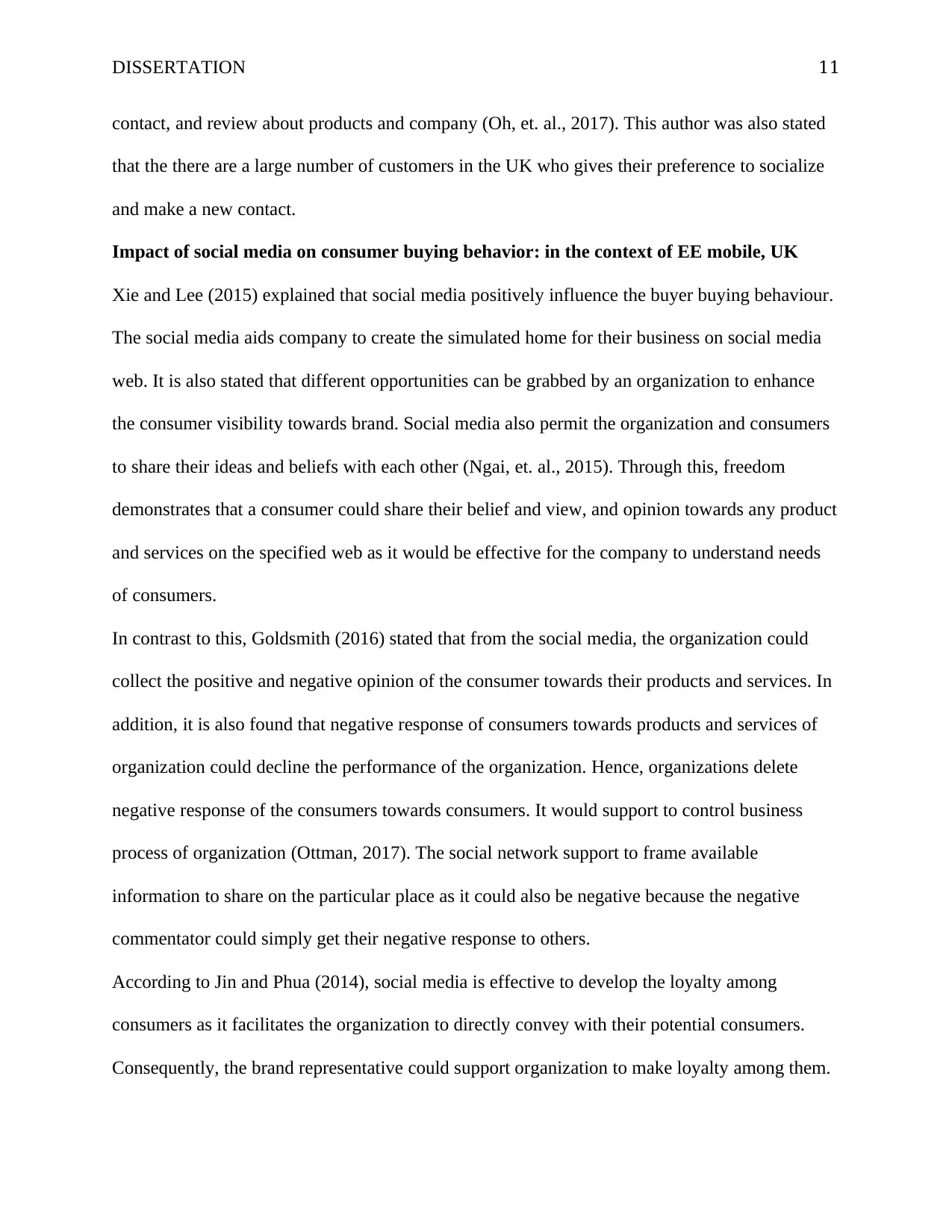
DISSERTATION 11
contact, and review about products and company (Oh, et. al., 2017). This author was also stated
that the there are a large number of customers in the UK who gives their preference to socialize
and make a new contact.
Impact of social media on consumer buying behavior: in the context of EE mobile, UK
Xie and Lee (2015) explained that social media positively influence the buyer buying behaviour.
The social media aids company to create the simulated home for their business on social media
web. It is also stated that different opportunities can be grabbed by an organization to enhance
the consumer visibility towards brand. Social media also permit the organization and consumers
to share their ideas and beliefs with each other (Ngai, et. al., 2015). Through this, freedom
demonstrates that a consumer could share their belief and view, and opinion towards any product
and services on the specified web as it would be effective for the company to understand needs
of consumers.
In contrast to this, Goldsmith (2016) stated that from the social media, the organization could
collect the positive and negative opinion of the consumer towards their products and services. In
addition, it is also found that negative response of consumers towards products and services of
organization could decline the performance of the organization. Hence, organizations delete
negative response of the consumers towards consumers. It would support to control business
process of organization (Ottman, 2017). The social network support to frame available
information to share on the particular place as it could also be negative because the negative
commentator could simply get their negative response to others.
According to Jin and Phua (2014), social media is effective to develop the loyalty among
consumers as it facilitates the organization to directly convey with their potential consumers.
Consequently, the brand representative could support organization to make loyalty among them.
contact, and review about products and company (Oh, et. al., 2017). This author was also stated
that the there are a large number of customers in the UK who gives their preference to socialize
and make a new contact.
Impact of social media on consumer buying behavior: in the context of EE mobile, UK
Xie and Lee (2015) explained that social media positively influence the buyer buying behaviour.
The social media aids company to create the simulated home for their business on social media
web. It is also stated that different opportunities can be grabbed by an organization to enhance
the consumer visibility towards brand. Social media also permit the organization and consumers
to share their ideas and beliefs with each other (Ngai, et. al., 2015). Through this, freedom
demonstrates that a consumer could share their belief and view, and opinion towards any product
and services on the specified web as it would be effective for the company to understand needs
of consumers.
In contrast to this, Goldsmith (2016) stated that from the social media, the organization could
collect the positive and negative opinion of the consumer towards their products and services. In
addition, it is also found that negative response of consumers towards products and services of
organization could decline the performance of the organization. Hence, organizations delete
negative response of the consumers towards consumers. It would support to control business
process of organization (Ottman, 2017). The social network support to frame available
information to share on the particular place as it could also be negative because the negative
commentator could simply get their negative response to others.
According to Jin and Phua (2014), social media is effective to develop the loyalty among
consumers as it facilitates the organization to directly convey with their potential consumers.
Consequently, the brand representative could support organization to make loyalty among them.
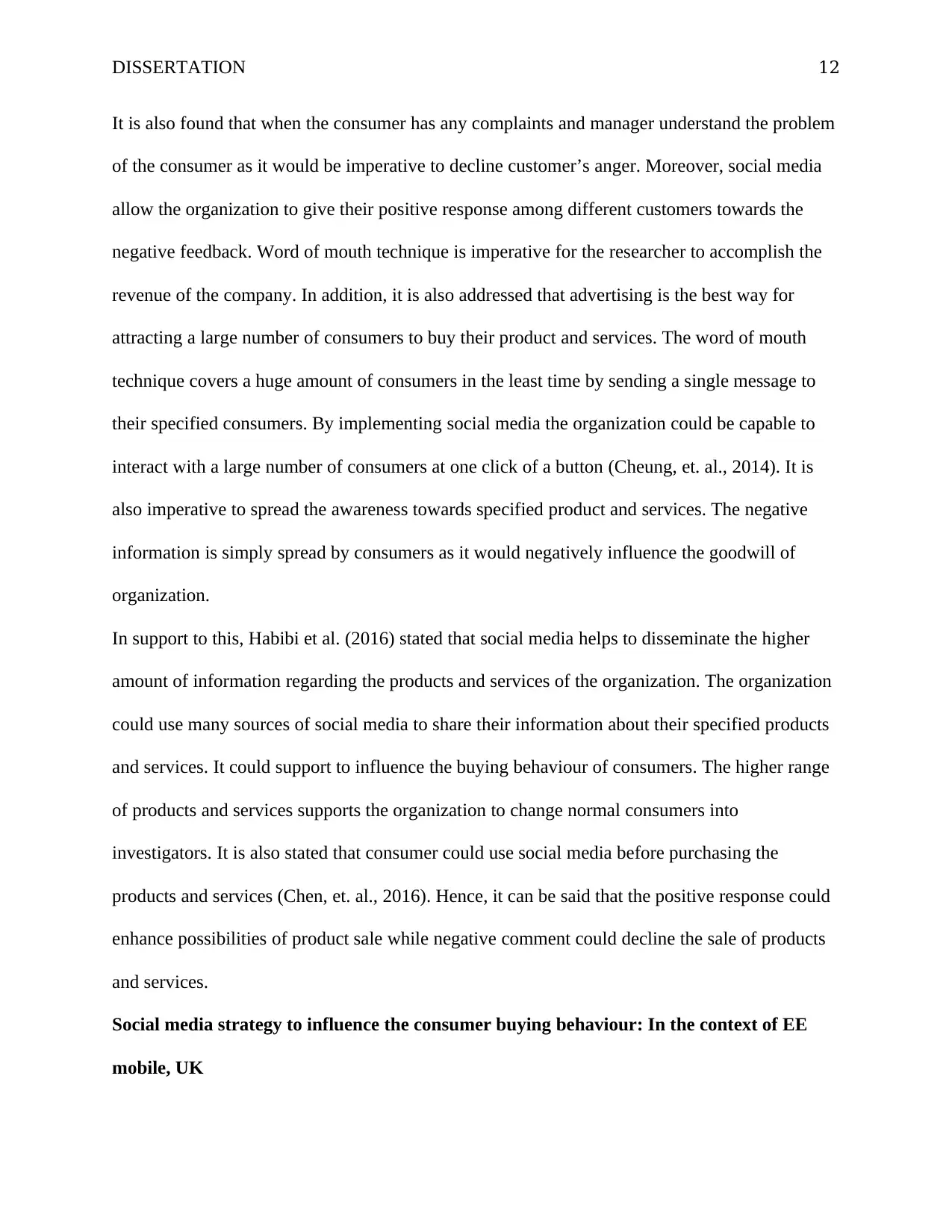
DISSERTATION 12
It is also found that when the consumer has any complaints and manager understand the problem
of the consumer as it would be imperative to decline customer’s anger. Moreover, social media
allow the organization to give their positive response among different customers towards the
negative feedback. Word of mouth technique is imperative for the researcher to accomplish the
revenue of the company. In addition, it is also addressed that advertising is the best way for
attracting a large number of consumers to buy their product and services. The word of mouth
technique covers a huge amount of consumers in the least time by sending a single message to
their specified consumers. By implementing social media the organization could be capable to
interact with a large number of consumers at one click of a button (Cheung, et. al., 2014). It is
also imperative to spread the awareness towards specified product and services. The negative
information is simply spread by consumers as it would negatively influence the goodwill of
organization.
In support to this, Habibi et al. (2016) stated that social media helps to disseminate the higher
amount of information regarding the products and services of the organization. The organization
could use many sources of social media to share their information about their specified products
and services. It could support to influence the buying behaviour of consumers. The higher range
of products and services supports the organization to change normal consumers into
investigators. It is also stated that consumer could use social media before purchasing the
products and services (Chen, et. al., 2016). Hence, it can be said that the positive response could
enhance possibilities of product sale while negative comment could decline the sale of products
and services.
Social media strategy to influence the consumer buying behaviour: In the context of EE
mobile, UK
It is also found that when the consumer has any complaints and manager understand the problem
of the consumer as it would be imperative to decline customer’s anger. Moreover, social media
allow the organization to give their positive response among different customers towards the
negative feedback. Word of mouth technique is imperative for the researcher to accomplish the
revenue of the company. In addition, it is also addressed that advertising is the best way for
attracting a large number of consumers to buy their product and services. The word of mouth
technique covers a huge amount of consumers in the least time by sending a single message to
their specified consumers. By implementing social media the organization could be capable to
interact with a large number of consumers at one click of a button (Cheung, et. al., 2014). It is
also imperative to spread the awareness towards specified product and services. The negative
information is simply spread by consumers as it would negatively influence the goodwill of
organization.
In support to this, Habibi et al. (2016) stated that social media helps to disseminate the higher
amount of information regarding the products and services of the organization. The organization
could use many sources of social media to share their information about their specified products
and services. It could support to influence the buying behaviour of consumers. The higher range
of products and services supports the organization to change normal consumers into
investigators. It is also stated that consumer could use social media before purchasing the
products and services (Chen, et. al., 2016). Hence, it can be said that the positive response could
enhance possibilities of product sale while negative comment could decline the sale of products
and services.
Social media strategy to influence the consumer buying behaviour: In the context of EE
mobile, UK
⊘ This is a preview!⊘
Do you want full access?
Subscribe today to unlock all pages.

Trusted by 1+ million students worldwide
1 out of 34
Related Documents
Your All-in-One AI-Powered Toolkit for Academic Success.
+13062052269
info@desklib.com
Available 24*7 on WhatsApp / Email
![[object Object]](/_next/static/media/star-bottom.7253800d.svg)
Unlock your academic potential
Copyright © 2020–2025 A2Z Services. All Rights Reserved. Developed and managed by ZUCOL.





